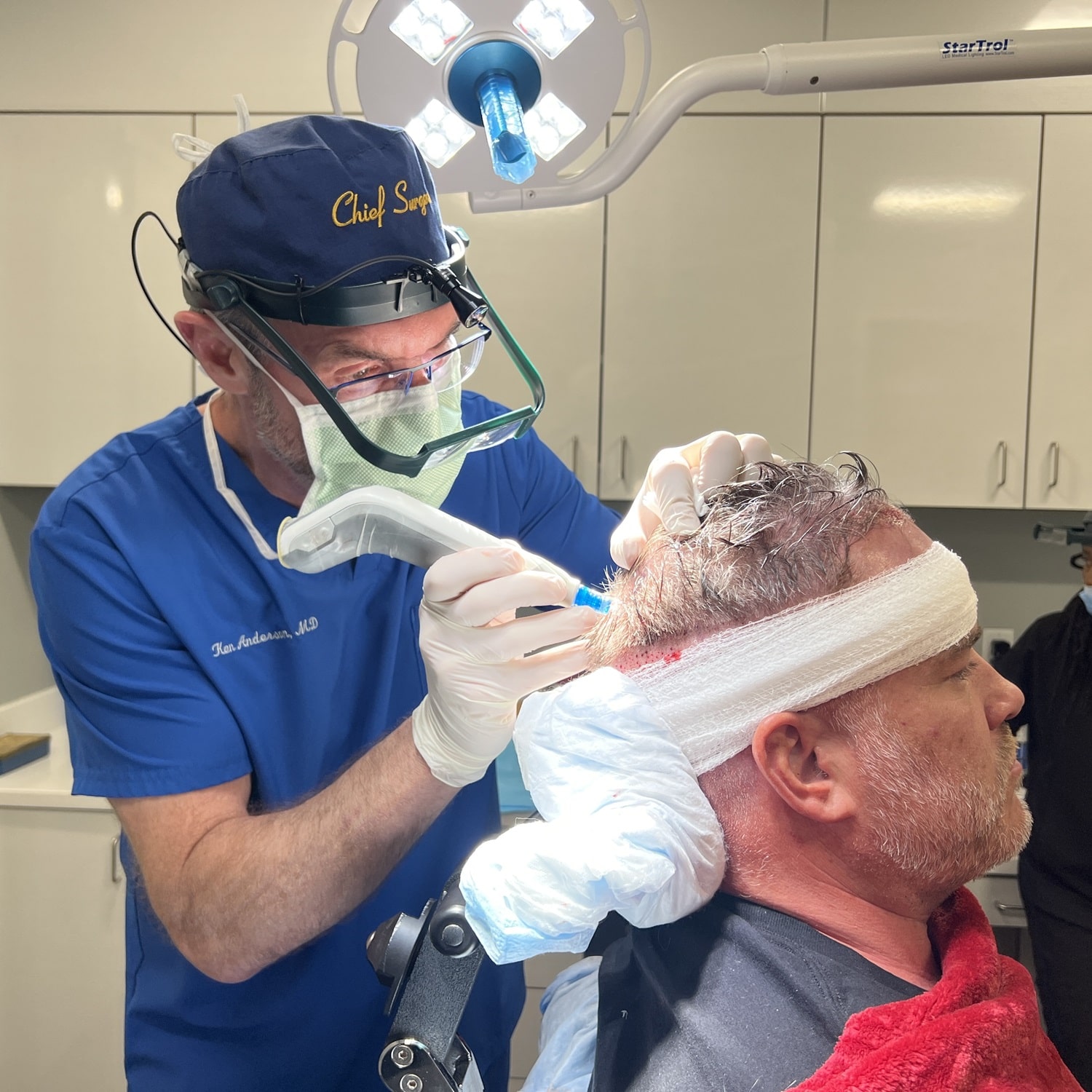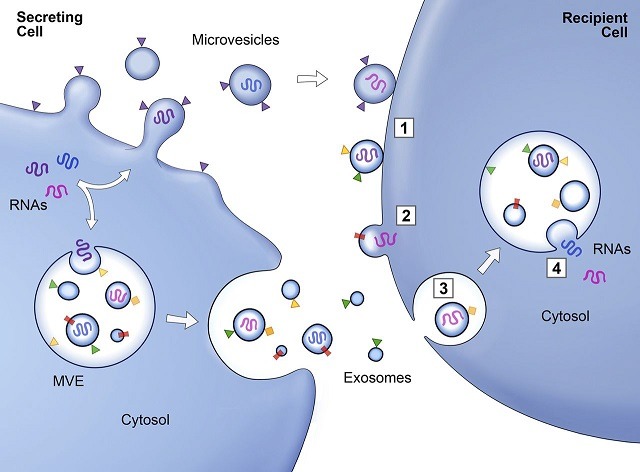REVOLUTIONIZING HAIR LOSS TREATMENTS
Unlocking the power of exosomes: Looking to the future of hair restoration
Exosomes, the tiny extracellular vesicles released by nearly all cell types in the body, are emerging as a groundbreaking solution in the fight against hair loss. Extracellular vesicles are essentially microscopic droplets of fat that cells release to communicate with other cells. These vesicles carry a diverse array of bioactive molecules such as proteins, lipids, RNAs, and microRNAs. In the realm of hair restoration, exosomes derived from human progenitor endothelial stem cells (hPESCs) hold significant promise, offering a potent regenerative capability for hair growth stimulation and improved scalp health.
What are exosomes?
Exosomes are tiny particles, smaller than 200 nanometers, released by almost every type of cell in the body. They are essential for communication between cells and play important roles in many bodily functions. Exosomes carry a variety of important molecules, such as proteins, fats, RNAs, and microRNAs, which allow them to affect how recipient cells behave and function.
Intercellular communication
One of the main roles of exosomes is to help cells communicate with each other. Exosomes deliver their molecular contents to other cells, changing how those cells act and function. This transfer happens in a few ways: exosomes can attach to target cells through specific surface interactions, be taken inside by a process called endocytosis, or merge directly with the cell membrane. This ability to deliver important molecules to other cells helps exosomes coordinate complex cellular activities and keep tissues balanced and healthy.
Immune system regulation
Exosomes are also important for the immune system. They help trigger or suppress immune responses by presenting antigens to immune cells. Exosomes can also carry molecules that regulate the activity of different immune cells, fine-tuning the immune response. This regulatory function is crucial for keeping the immune system balanced and preventing excessive inflammation or autoimmunity.
Tissue repair and regeneration
Exosomes promote tissue healing and regeneration in several ways:
- Enhancing cell proliferation: Exosomes are highly effective in enhancing cellular proliferation, which is the process of cells growing and dividing to create new cells. This is critical for the health of hair follicles, as the continuous production of new cells supports the growth of strong, healthy hair. By delivering key growth factors and signaling molecules, exosomes stimulate the division and multiplication of cells within the hair follicle. This increased cellular activity helps to reinforce the hair growth cycle, prevent follicle shrinkage, and potentially reverse hair loss by ensuring that hair follicles remain active and capable of producing new hair.
- Cell migration: Exosomes play a crucial role in promoting cellular migration, which is the movement of cells to specific locations where they are needed. In the context of hair growth, this process is essential for the transition from the resting phase (telogen) to the active growth phase (anagen) of the hair follicle cycle. Exosomes contain signaling molecules that stimulate the movement of cells, such as dermal papilla cells, to the hair follicle. This migration is vital for initiating and sustaining new hair growth. By enhancing cellular migration, exosomes help to rejuvenate hair follicles, promote healthier hair growth, and combat hair loss more effectively.
- Angiogenesis: Exosomes are powerful promoters of angiogenesis, the process by which new blood vessels form from existing ones. This is particularly important for hair growth, as healthy blood circulation provides hair follicles with the oxygen and nutrients they need to thrive. By delivering growth factors and other signaling molecules, exosomes encourage the development of new blood vessels around hair follicles, enhancing the blood supply to these areas. Improved angiogenesis ensures that hair follicles receive the nourishment required for strong, healthy hair growth, making exosome therapy a promising approach to treating hair loss and revitalizing thinning hair.
What do exosomes have to do with hair loss?
Exosomes have garnered significant attention in the field of hair restoration due to their potent regenerative capabilities. One promising avenue is the use of exosome injections derived from stem cells isolated from umbilical cord blood. These exosomes are rich in bioactive molecules that can potentially improve hair growth stimulation and overall scalp health. Exosomes’ incredibly small size allows them to deliver their cargo (eg: growth factor proteins) across cellular barriers in the scalp that are typically impermeable to larger cells, making them highly efficient in therapeutic applications.
Hair follicles, like other tissues in the body, require a supportive environment for growth, maintenance, and repair. Exosomes contribute to this environment by facilitating the delivery of key bioactive molecules and growth factors that can influence hair follicle cells’ behavior and function. Read on to learn how exosomes impact hair follicle regeneration.
Promoting hair follicle regeneration
Scientists understand that exosomes carry many growth factors and cytokines, and they believe that exosomes can stimulate the growth of dermal papilla cells, which are essential in the hair growth cycle. Some of the molecules, contained within the exosomes, that are thought to be instrumental in creating a nurturing environment for hair follicle regeneration are IGFs, VEGF, and PDGF:
Insulin-like Growth Factors
Insulin-like Growth Factors (IGFs), found in exosomes, are crucial for promoting cell growth and survival. They play a key role in stimulating the proliferation and specialization of dermal papilla cells, which are vital for initiating and maintaining the anagen phase – the active growth phase – of the hair cycle. By encouraging these cells to multiply and perform their specialized functions, IGFs help to sustain the growth of new hair and ensure that hair follicles remain in a healthy, active state. This support of the anagen phase is essential for achieving and maintaining thick, healthy hair, making IGFs a significant factor in preventing and reversing hair loss.
Vascular Endothelial Growth Factor
Vascular Endothelial Growth Factor (VEGF), present in exosomes, is a powerful promoter of angiogenesis, the process by which new blood vessels form. By encouraging the development of these new vessels, VEGF ensures that hair follicles receive an adequate and consistent blood supply. This increased blood flow delivers essential nutrients and oxygen directly to the hair follicles, which are critical for their growth, strength, and overall health. By enhancing the vascular network around hair follicles, VEGF not only supports healthy hair growth but also helps to prevent hair thinning and loss by ensuring that the follicles remain well-nourished and active.
Platelet-Derived Growth Factor
Platelet-Derived Growth Factor (PDGF), found in exosomes, plays a crucial role in tissue repair and remodeling by promoting the growth and division of cells involved in healing. In the context of hair follicles, PDGF helps to maintain a healthy environment by encouraging the repair of damaged tissues and supporting the structural integrity of the follicle. This process is vital for the regeneration of hair follicles, ensuring that they remain active and capable of producing new hair. By enhancing tissue repair and remodeling, PDGF contributes to stronger, healthier hair growth and can be a key factor in combating hair loss.
Reducing inflammation
Chronic inflammation is a significant contributor to hair loss, as it can damage hair follicles and disrupt the normal hair growth cycle. Exosomes, with their potent anti-inflammatory properties, offer a promising solution to this problem. These tiny vesicles contain molecules such as Interleukin-1 Receptor Antagonist (IL-1RA) and Transforming Growth Factor-beta (TGF-β), both of which play critical roles in reducing inflammation. IL-1RA works by blocking the inflammatory signals that can harm hair follicles, while TGF-β helps to regulate the immune response and promote tissue repair. By delivering these anti-inflammatory molecules directly to the scalp, exosomes can lower inflammation around hair follicles, creating a healthier environment that supports hair growth and helps prevent further hair loss. This ability to modulate inflammation makes exosome therapy a powerful tool in the fight against hair loss, particularly for individuals suffering from conditions where inflammation is a key factor.
- Interleukin-1 Receptor Antagonist (IL-1RA): This molecule blocks the activity of interleukin-1, a substance that causes inflammation. By reducing inflammation, IL-1RA protects hair follicles from inflammatory damage.
- Transforming Growth Factor Beta (TGF-β): TGF-β has two roles: it regulates inflammation and promotes tissue repair. Its presence in exosomes helps balance the immune response and regeneration, which is essential for healthy hair follicles.
The regenerative potential of exosomes goes beyond just providing growth factors; they also enhance communication between cells within the hair follicle environment. By transferring genetic material, proteins, and lipids to other cells, exosomes can modify cellular activity and promote coordinated responses to injury or stress. This multifaceted approach makes exosome therapy a powerful tool in supporting hair growth and combating hair loss.
- MicroRNAs (miRNAs): These small non-coding RNAs are key regulators of gene expression in recipient cells. They influence processes such as cell cycle regulation, cell death, and differentiation. Exosomal miRNAs can strengthen hair follicle cells and enhance their regenerative capacity, making them more resilient and capable of sustaining healthy hair growth.
- Proteins and Lipids: In addition to genetic material, exosomes deliver various proteins and lipids that are crucial for cell function and structural integrity. These components help maintain the health and functionality of hair follicle cells, ensuring that they operate optimally within the hair follicle environment. By supporting these cellular processes, exosomes contribute to healthier, stronger hair growth.
Clinical applications and the future of exosomes for hair loss
The application of exosomes in hair restoration is a rapidly evolving field. Clinical studies have shown promising results, with exosome therapy leading to significant improvements in hair density and thickness. However, further research is needed to fully understand the mechanisms through which exosomes exert their effects and to optimize their therapeutic use. Here are the early standouts for how the hair restoration industry can use exosomes:
- Scalp Injections: The most effective method of administering exosomes for hair restoration is thought to be through direct scalp injections. This approach ensures that exosomes reach the hair follicles effectively, delivering their regenerative payload directly to the target area.
- Topical Applications: Research is ongoing into the development of exosome-based topical treatments, which could offer a non-invasive alternative for individuals seeking hair restoration.
- Combination Therapies: Exosomes are also being explored as part of combination therapies, working synergistically with other hair restoration techniques such as microneedling, platelet-rich fibrin (PRF), and platelet-rich plasma (PRP) to enhance overall outcomes. Exosome injections are also synergistic with low-level laser therapy (LLLT) and topical medications.

Frequently asked questions
Can regenerative medicine cure hair loss?
Because the exosomes are from another person’s stem cells, won’t there be a rejection of the exosomes by my body’s immune system?While regenerative medicine treatments are effective for hair thinning, can slow the progression of hair loss, and, in some cases, restore hair thickness, they’re technically not “curing” androgenetic alopecia, which is the most common type of hair loss. It’s not a disease or a disorder. It’s simply a natural variant of the human condition. Whether or not hair loss will affect you is primarily determined by your genetics – both your mom’s and your dad’s sides of the family. However, the rate at which you lose your hair can be slowed through medical interventions like regenerative medicine.
Am I an ideal candidate for regenerative medicine treatments for hair loss?
If you’re in the early stages of hair loss or have just noticed your hair is starting to thin, you’re likely a good candidate for regenerative medicine treatments. If you have no hair left in a given area or the hair has been gone for years, it’s less likely you’ll see a noticeable change. Every situation is unique, so the best way to determine if you’re an ideal candidate is to schedule an appointment with one of our qualified surgeons to be evaluated.
Is there a recovery period or downtime after regenerative medicine treatments?
After regenerative medicine treatments, there is minimal downtime. You can plan to resume your regular activities the following day after your treatment.
Do regenerative medicine treatments hurt?
While the injections might result in mild discomfort, a local anesthetic is administered before we begin to alleviate any pain you may experience during the treatment.
How many regenerative medicine treatments will I need?
The required number of treatments differs among individuals. The best way to find out what you’ll personally need to be evaluated by one of our surgeons. We offer in-person and virtual appointment options at each of our offices to accommodate your schedule.
Because the exosomes are from another person’s stem cells, won’t there be a rejection of the exosomes by my body’s immune system?
Exosomes derived from cord blood are not typically rejected by the recipient’s immune system when injected into the scalp because they lack the features that commonly trigger immune responses. Unlike whole cells or tissues, exosomes do not contain DNA and have minimal, if any, surface markers that could be recognized as foreign by the immune system. This makes them less likely to provoke an immune reaction. Additionally, exosomes carry immunomodulatory molecules that can actually help to reduce inflammation and promote healing, further lowering the risk of rejection. This unique property allows them to be used safely and effectively in therapies, such as those for treating hair loss.
To see the results of our regenerative medicine treatments, check out the before & after gallery here.
Ready to take that next step? Schedule a complimentary consultation with one of our surgeons at the Anderson Center for Hair. Our experts will provide personalized advice to help you achieve your hair restoration goals.
Sources
- Gangadaran P, Rajendran RL, Kwack MH, Jeyaraman M, Hong CM, Sung YK, Ahn BC. Application of Cell-Derived Extracellular Vesicles and Engineered Nanovesicles for Hair Growth: From Mechanisms to Therapeutics. Front Cell Dev Biol. 2022 Jul 14;10:963278. doi: 10.3389/fcell.2022.963278. PMID: 35912106; PMCID: PMC9329781.
- Manzoor T, Saleem A, Farooq N, Dar LA, Nazir J, Saleem S, Ismail S, Gugjoo MB, Shiekh PA, Ahmad SM. Extracellular vesicles derived from mesenchymal stem cells – a novel therapeutic tool in infectious diseases. Inflamm Regen. 2023 Feb 28;43(1):17. doi: 10.1186/s41232-023-00266-6. PMID: 36849892; PMCID: PMC9970864.
- Oh HA, Kwak J, Kim BJ, Jin HJ, Park WS, Choi SJ, Oh W, Um S. Migration Inhibitory Factor in Conditioned Medium from Human Umbilical Cord Blood-Derived Mesenchymal Stromal Cells Stimulates Hair Growth. Cells. 2020 May 28;9(6):1344. doi: 10.3390/cells9061344. PMID: 32481584; PMCID: PMC7349163.
- Sasaki GH. Clinical Use of Extracellular Vesicles in the Management of Male and Female Pattern Hair Loss: A Preliminary Retrospective Institutional Review Board Safety and Efficacy Study. Aesthet Surg J Open Forum. 2022 May 24;4:ojac045. doi: 10.1093/asjof/ojac045. PMID: 35923863; PMCID: PMC9342625.





